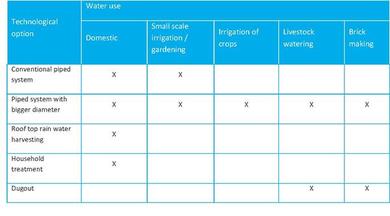Tool 20
TOOL 20. SELECTION OF TECHNOLOGIES FOR MULTIPLE-USES
To identify appropriate technological options to respond to multiple water demands.
OBJECTIVE
To identify appropriate technological options to respond to multiple water demands.
METHOD
Step 1: Identify possible water resources and technologies for addressing the identified multiple water demands.
Step 2: Make a table with the technological options on one side, and demands for water use on the other. Indicate which technological options will be able to provide water for which demands. See Table 14 for an example.
Table 14 - Example of technological options for different water uses

Source: ZIMWASH, 2010
Step 3: Discuss the advantages and disadvantages of the identified technology options, and their implications for community contribution.
- Is there one technology option that can satisfy all demands? What is it?
- If not, can combinations of technological options that can meet the demands be identified? In the selection of alternatives, consider:
- The use of alternatives, especially for large consumers.
- The use of water of different qualities for different purposes, for instance irrigation of crops does not require good water quality.
- The use of existing infrastructure that is obsolete but can be used for productive purposes.
- Communal productive activities such as communal gardens or water troughs for watering livestock.
- Can these required contributions from the community be met and sustained? If not, the ambition level will have to be reduced. For example, a community may identify the desire for field scale irrigation and the necessity of a motorised pump for that. However, if this would require a contribution of the community beyond their means, for instance to pay for diesel, it should reduce its ambition. Several iterations may be needed to come to a realistic combination of technologies to meet the demand.
Step 4: Based on this, the identified technology options – a single option or a combination of different options – depending on the feasibility for the community. It endeavours to eliminate those options which are technically or financially not feasible beforehand, but tries to leave options open as much as possible.
Step 5: Develop a conceptual design for each of the options that identifies the main elements of the system, its advantages and disadvantages, and a preliminary identification of costs and fees.
BASED ON
Tools 10 and 11 in: Smits, S. and Mejía, T., 2011. Guía para la Planificación e Implementación de Proyectos de Usos Múltiples del Agua, The Hague / Tegucigalpa: IRC/ RASHON.
Tool 8 in: ZIMWASH, 2010. Guidelines for Planning for Water for Livelihoods, Harare: ZIMWASH Project.
